Step by Step of Essence of Lavender 30 x 24 Oil on Linen
Palette colors:
The palette that you see on the right is out of my travel box. Many times instead of squeezing color out on my studio taboret, I just clamp this palette down, and can use both surfaces to mix color.
So from left to right:
Raw umber, transparent oxide red, Sevres, blue, ultramarine blue, quinacridone violet, peylene red, cad red
light, cad yellow dp, cad yellow lt. titanium/zinc white.
It's my basic double primary palette, with a Quinacridone violet and a warm and a cool brown thrown in.
The two blobs of color to the left are just palette scrapings left over from the previous day.
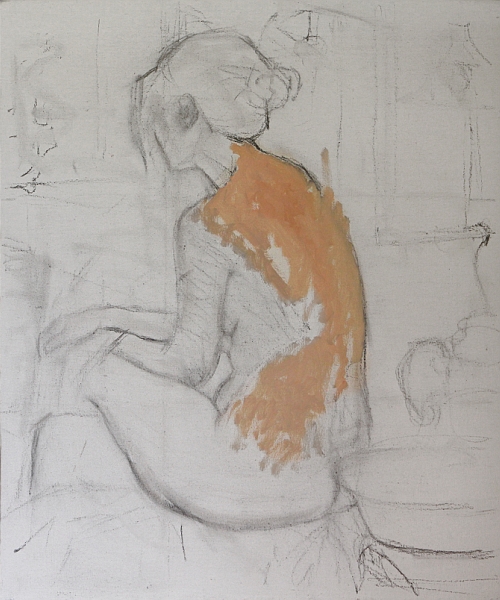 |
Step 1:
For many of my paintings, particularly undraped figures, I
will do a separate drawing that I can refer back to. But in this case I started
the charcoal drawing directly on the white ground of the linen. After many
changes of both placement and proportions I ended up with this drawing…it’s
certainly nothing fancy. I start with the paint by applying color to the light
side of the figure using a mixture of white, cad yellow lt. and perylene red with
a small amount of sevres blue (sevres blue is a Rembrandt color which is thalo
blue and white). I want to keep the paint thin at this stage, so I use a
generous amount of OMS to thin the mixtures.
|
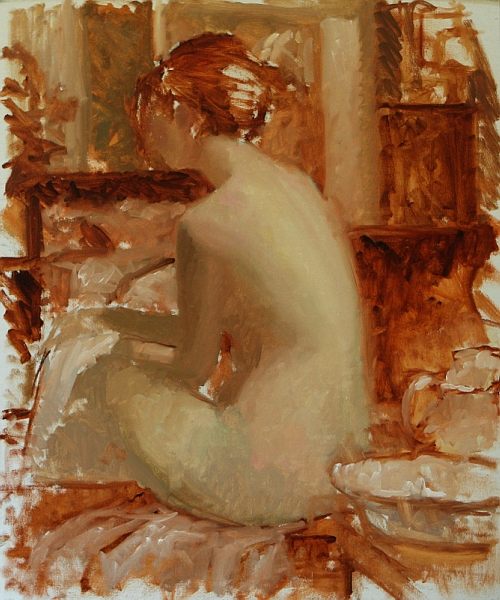 |
Step 2:
I continue to apply the basic flesh tones over most of the
figure. I also mass in the general tones of the background, keeping them toward
the warmer side and not pushing the values too far light or dark. As I work
into the darker flesh tones I add some transparent earth red to the mixture. I’m
paying particular attention to the grouping of the overall tones, trying to
keep similar tones massed together, so at this stage I can get a feeling of
where the painting is going.
|
 |
Step 3:
“Wow what was I thinking?!” was my first thought the next
day. I was still happy with the figure but I felt that my background was too
broken up and didn’t seem to make the best design. My tones weren’t as grouped
as I had thought they were. I didn’t really want to scrape the panting down,
but that little annoying voice kept telling me that I’d be sorry if I didn’t.
With some trepidation, I went for it, scraping and wiping down most of the
surface, fortunately the painting was still a little wet from the previous day,
so the paint came off easily. I then proceeded to change the elements in the
background, focusing on simplifying the design. With a few changes of furniture
I was able to facilitate a simpler triangular design that focused more strongly
on the figure. I then reestablished the figure along with the new changes in
the background. The changes took most of day but it was definitely worth it.
|
 |
Step 4 and 5:
The next day I started working in earnest on the flesh
tones. The figure is being lit with a cool north light, so I add sevres blue
and quinacridone violet to the basic mixture of yellow, red and white to give the flesh a cool
tone on the light side. On the shadow side I keep my mixtures warmer by adding
transparent red and cad. red light to the mixture. I’m not thinning the paint
much. I enjoy putting the paint down thickly on the light side and a little
thinner on the shadow side, that way there is more interest in the paint
layers. As I apply the paint, I want to just put it down and not move it around
too much. I will do some blending with my fingers. |
 |
Step 5: (Continuation of step 4):
You can see the flesh has taken on some fun color change-ups. It has taken me all day to work this stage. |
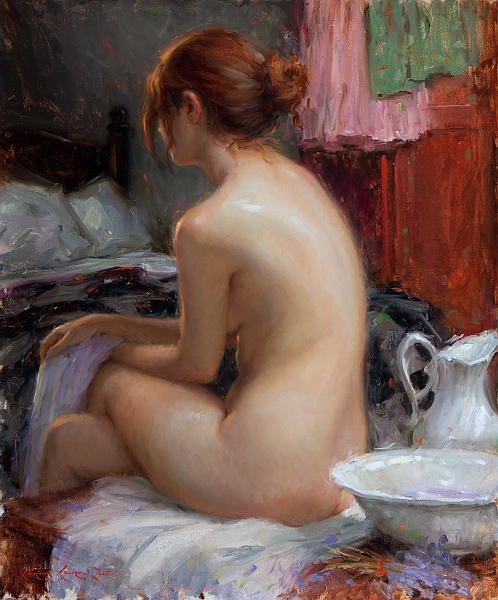 |
Step 6:
This is the finished painting. I know it made a big jump to
this stage. I got so into the painting I forgot to shoot it along the way--sorry.
This stage represents two days work, but really all I did was to continue to
resolve the flesh tones and shapes and give the edges some variety. I work all
around the painting, trying not to spend too much time on any one spot. At some
point during these last days I decided to move the bedspread and reduce the
white sheet. It helped to get the dark against her shadow side so that the
values didn’t jump too much; it added a solid feeling to the left side of the
painting.
|
Black & white and
reduced value illustrations:
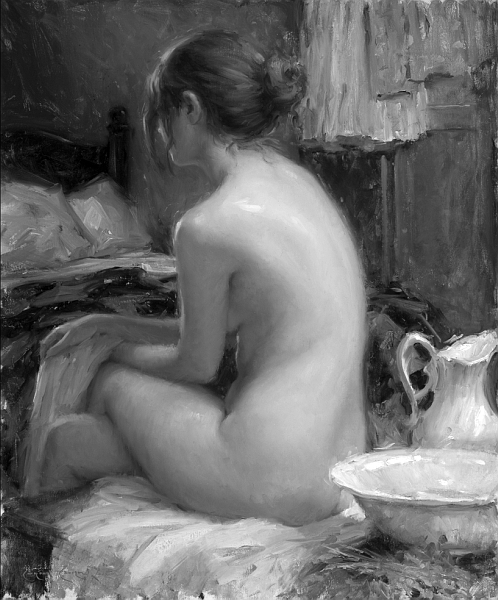 |
| I like to show my painting in black & white to illustrate the
organization of the shapes and value masses. I used a lot of color in
the painting, but look at it in black & white, it seems very tonal—I
think it reads quite well. |
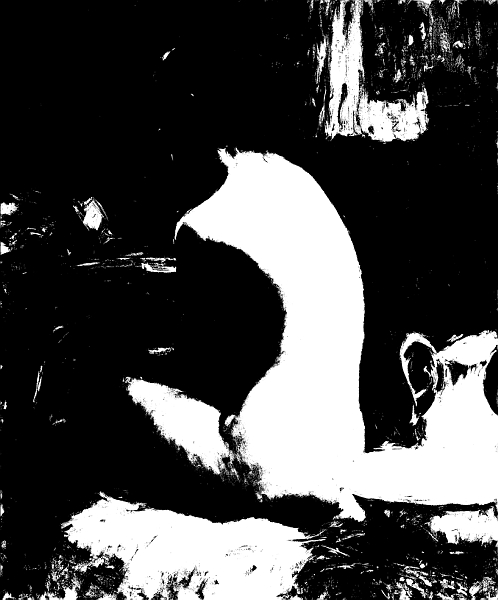 |
Now let’s look at it in two values. I used
Photoshop to reduce the image down to two values only, notice the grouping of
shapes. It makes for some abstract shapes (there is no face), but I feel it is
well balanced.
|
 |
Here it is in 3 values. It takes on more reality, it looks
like a person. I think it is important how the middle values hold the painting
together.
That's it, Thanks for looking.
|










